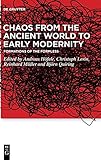Chaos from the Ancient World to Early Modernity : Formations of the Formless / ed. by Christoph Levin, Andreas Höfele, Reinhard Müller, Björn Quiring.
Material type: TextPublisher: Berlin ; Boston : De Gruyter, [2020]Copyright date: ©2021Description: 1 online resource (VI, 238 p.)Content type:
TextPublisher: Berlin ; Boston : De Gruyter, [2020]Copyright date: ©2021Description: 1 online resource (VI, 238 p.)Content type: - 9783110653694
- 9783110653984
- 9783110655001
- 003.857 23
- MLCM 2021/45129 (Q)
- Q172.5.C45 C426 2021eb
- online - DeGruyter
- Issued also in print.
| Item type | Current library | Call number | URL | Status | Notes | Barcode | |
|---|---|---|---|---|---|---|---|
 eBook
eBook
|
Biblioteca "Angelicum" Pont. Univ. S.Tommaso d'Aquino Nuvola online | online - DeGruyter (Browse shelf(Opens below)) | Online access | Not for loan (Accesso limitato) | Accesso per gli utenti autorizzati / Access for authorized users | (dgr)9783110655001 |
Frontmatter -- Table of Contents -- Image Credits -- Introduction -- The Invention of Chaos -- Zwischen Chaos und Ordnung -- Paradise Established -- Das umgestürzte Recht (Amos 5,7) -- Chaos in komischer Literatur des späten Mittelalters und der frühen Neuzeit -- Mixed Abysses -- “Come to Great Confusion” -- Sympathy Lost -- The Coming Chaos in Spenser and Milton -- The Tartarean Jurisdiction of Chaos in Milton’s Paradise Lost -- Naturalization of Chaos and Apotheosis of Order -- Index of Authors
restricted access online access with authorization star
http://purl.org/coar/access_right/c_16ec
Chaos is a perennial source of fear and fascination. The original "formless void" (tohu-wa-bohu) mentioned in the book of Genesis, chaos precedes the created world: a state of anarchy before the establishment of cosmic order. But chaos has frequently also been conceived of as a force that persists in the cosmos and in society and threatens to undo them both. From the cultures of the ancient Near East and the Old Testament to early modernity, notions of the divine have included the power to check and contain as well as to unleash chaos as a sanction for the violation of social and ethical norms. Yet chaos has also been construed as a necessary supplement to order, a region of pure potentiality at the base of reality that provides the raw material of creation or even constitutes a kind of alternative order itself. As such, it generates its own peculiar 'formations of the formless'. Focusing on the connection between the cosmic and the political, this volume traces the continuities and re-conceptualizations of chaos from the ancient Near East to early modern Europe across a variety of cultures, discourses and texts. One of the questions it poses is how these pre-modern 'chaos theories' have survived into and reverberate in our own time.
Issued also in print.
Mode of access: Internet via World Wide Web.
In English.
Description based on online resource; title from PDF title page (publisher's Web site, viewed 01. Dez 2022)


